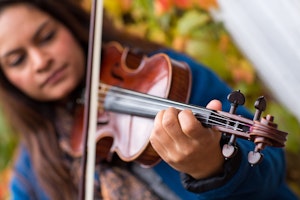Her father put on a cassette featuring the Indian violinist Dr Lakshminarayana Subramaniam. From that moment on, the three-year-old girl was hooked. She was absolutely determined to become a violinist.
“It was so fantastic! I asked my father who was playing, and he told me that it was an uncle in India,” says Bansal.
That was the beginning of the beginning. This autumn there was a new beginning for Harpreet Bansal, when she began a three-year-long senior research fellowship at the Norwegian Academy of Music (NMH). Under the title “The Vocal Violinist: Learning Through Teaching”, her research will explore and delve more deeply into the classical music of northern India. The main focus of her PhD study is the instrumental singing style of “gayaki ang”, as it is known in India.
“In Indian classical music there are two ways of playing an instrument. One of these is playing as though you were singing. This is what I want to investigate: the transferral from song to instrument. The other way of playing is more instrumental – a little more percussive,” she explains.
Father and guru
And in many ways this is how she herself entered the world of music. Because although three-year-old Harpreet had decided to become a violinist, she did not begin to play the violin until she was admitted to the local community music school at the age of eight. Until then she had been singing and playing the harmonium, which is the customary way of beginning to study the classical northern Indian music tradition.
“You learn to sing first. Everything is done by ear. The teacher sings, and you repeat what you heard without using written notation. Then afterwards you can transfer this to an instrument if you want.” This method, or tradition, is called “guru shishya parampara”.
“Guru means teacher, shishya is student, and the last word means tradition,” Bansal clarifies.
Her guru has been her father, Harbhajan Singh Bansal. He is also a musician, and Harpreet Bansal grew up with the Indian tradition as a powerful presence due to his influence.
“He is a singer, but has also taught many instruments. He moved to Norway in 1973, and has been involved with music his entire life.”
Do you think that you would have become a musician without him?
“Probably not,” Bansal laughs.“Indians and Pakistanis often want their children to become doctors or lawyers, not musicians. The future prospects for musicians aren’t as bright.”

